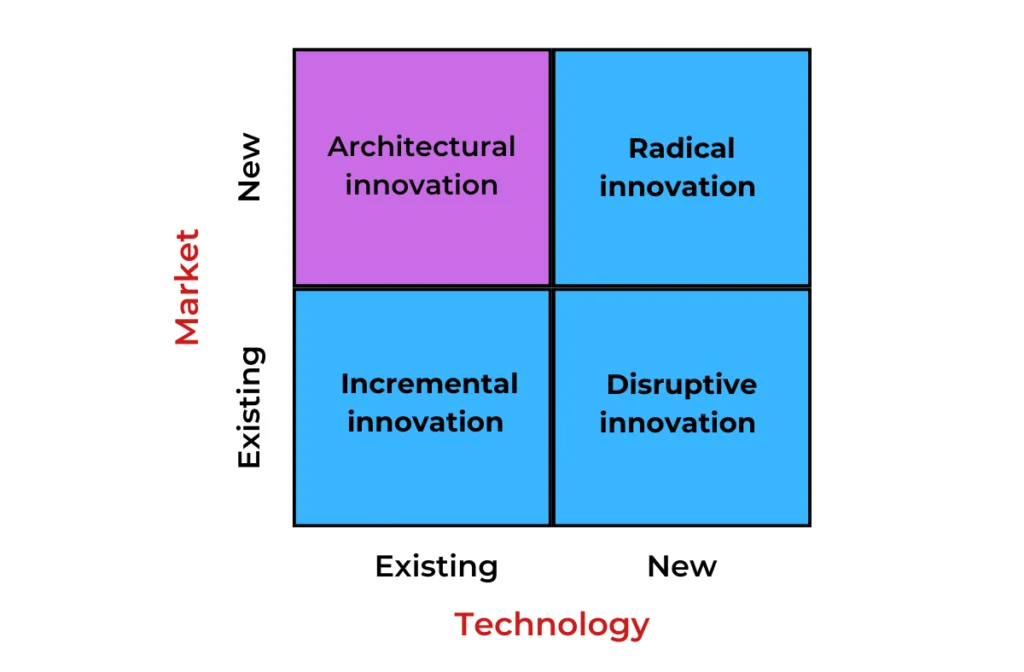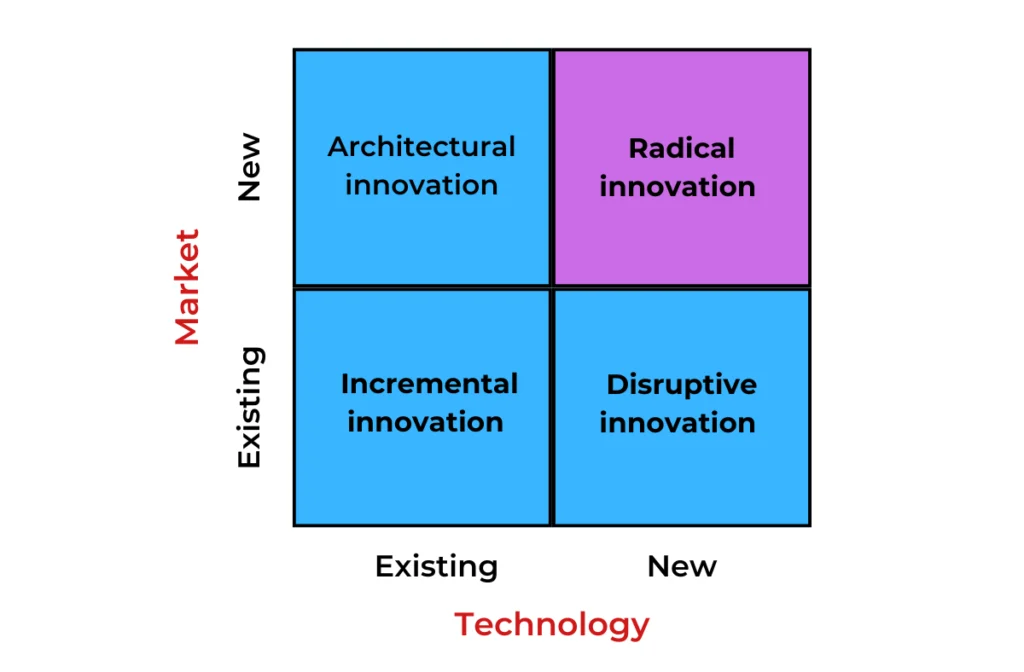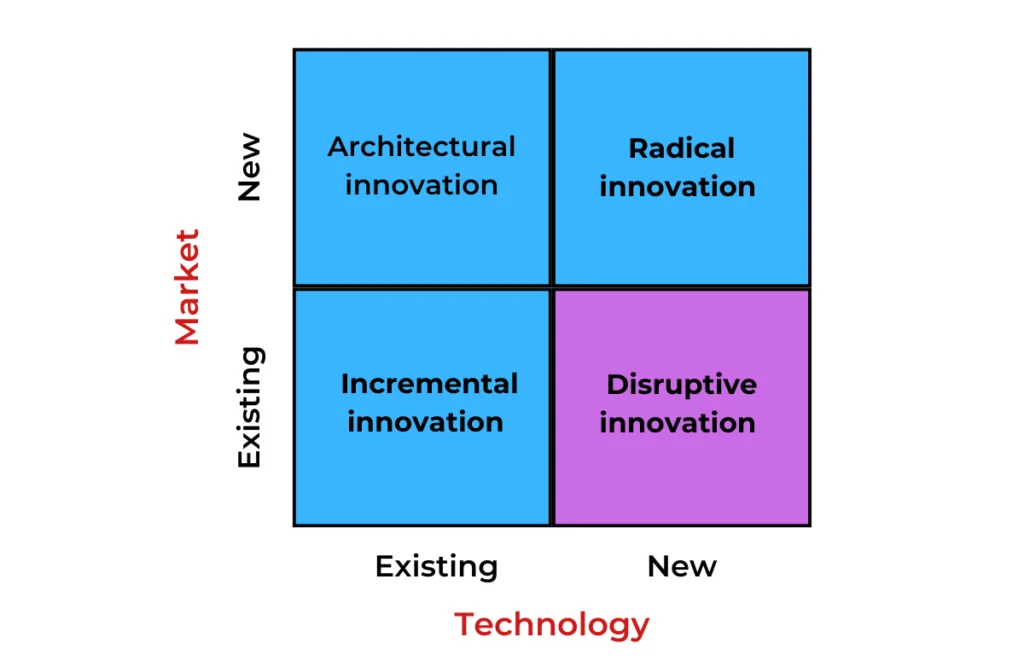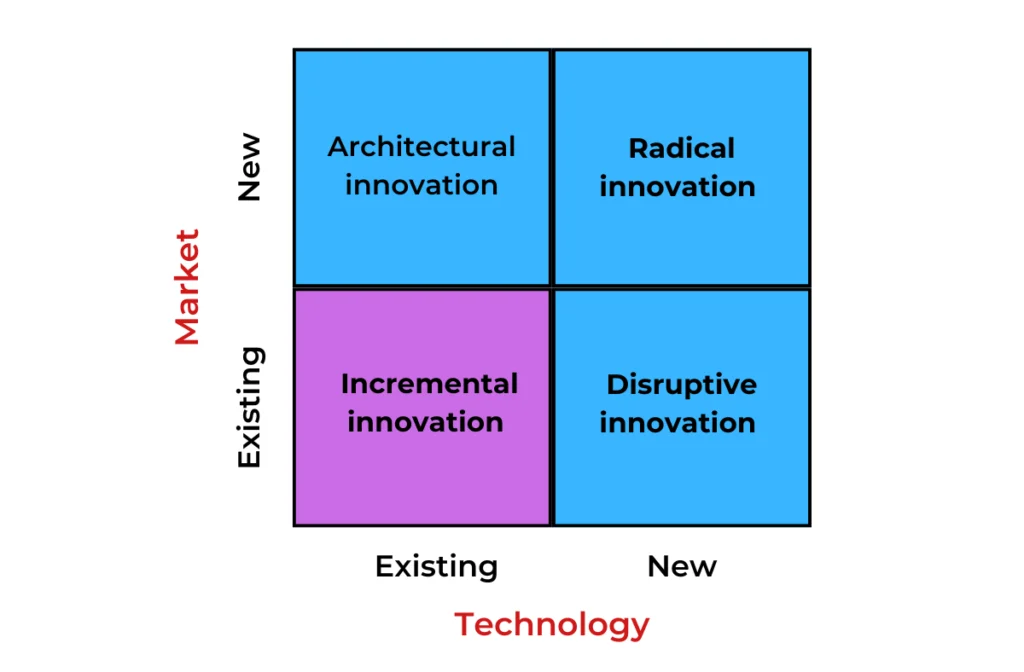📢 Sign up to my newsletter and never miss a beat!
In today’s rapidly evolving market landscape, innovation is not just a buzzword but a critical driver of success for businesses across all industries. Understanding the distinct approaches to innovation can help companies strategically harness their creative efforts to stay competitive and relevant. This article delves into the four main types of product innovation: architectural, radical, disruptive, and incremental. Each type offers a unique approach to leveraging new or existing technologies and markets, from reconfiguring existing systems to address new market needs with architectural innovation, to making groundbreaking leaps with radical innovation, challenging market norms with disruptive strategies, or refining existing products through incremental improvements. We will explore how these innovations function, their strategic importance, and their potential impact on industries and markets.
Architectural Innovation

Architectural innovation refers to the process of rethinking and rearranging existing technologies to create a new product that addresses the needs of a different market segment. This type of innovation capitalizes on the reliability and familiarity of established technologies, yet it reimagines their application to capture new opportunities or solve unaddressed problems.
Taking the example of transforming traditional wristwatches into smartwatches: traditional wristwatches primarily serve the function of timekeeping, using well-understood mechanical or electronic technology. However, as consumer interests shifted towards health and fitness tracking, companies recognized the opportunity to enhance the utility of wristwatches by integrating capabilities like heart rate monitoring, step counting, and GPS tracking.
In an architectural innovation such as this, the core technology of the wristwatch—the basic electronic components and digital display—remains mostly unchanged. What changes significantly is how these components are configured and the additional features they support. This reconfiguration involves both adding new technological components and redesigning the user interface to accommodate interactions beyond timekeeping, such as health monitoring and mobile connectivity.
The shift is not just technological but also strategic, as the innovation opens up new markets. Initially, wristwatches were marketed primarily to people concerned with fashion or needing a simple way to keep time. With the advent of smartwatches, the market expanded to include fitness enthusiasts, tech-savvy consumers, and health-conscious individuals.
Architectural innovation thus bridges the gap between existing technologies and emerging market needs without the necessity of developing a completely new technology. It provides a sustainable path for growth for businesses that can leverage their existing technological strengths in new and diverse applications. This approach reduces the risk and cost associated with radical innovation while still allowing companies to tap into new customer segments and revenue streams.
Radical Innovation

Radical innovation represents a profound shift in technology and market dynamics, introducing entirely new concepts and products that can redefine industries. This type of innovation is characterized by the creation of technologies that did not previously exist and the cultivation of markets that have not been previously served. The novelty and scope of radical innovations mean they can completely alter how industries operate, how consumers behave, and even how societies function.
Taking the examples of the first airplanes and the internet:
- Airplanes: Prior to the invention of the airplane, long-distance travel was limited to ships and trains, which were constrained by geographical obstacles and lengthy travel times. The development of airplanes introduced a new technology that utilized principles of aerodynamics and propulsion previously unexplored for passenger transport. This innovation did not just create a new product; it spawned an entire industry centered around air travel, including airlines, airports, and aircraft manufacturing. The market for air travel was new—targeting faster transcontinental and international travel—which dramatically changed the dynamics of global interaction and economy.
- The Internet: Similarly, the invention of the internet introduced a groundbreaking technology that facilitated digital connectivity on a scale that was previously unimaginable. Before the internet, information exchange and communication were limited to print, telephone, and broadcast media, which had significant limitations in speed, reach, and interactivity. The internet’s development created a platform for instant global communication, a vast array of new digital services, and ultimately, a new digital economy. It cultivated entirely new markets in e-commerce, online advertising, streaming services, and more, fundamentally transforming numerous aspects of business and personal life.
Radical innovations such as these are often the result of visionary thinking and risk-taking, requiring significant investment in research and development. The risks associated with radical innovation are high because both the technology and the market are unproven—there is no guarantee that the new technology will be feasible or that a sufficient market will develop for the new product. However, the potential rewards are substantial. Successful radical innovations can lead to dominance in new markets and can establish standards and platforms that shape entire industries for decades.
Overall, radical innovations are rare because they require breaking away from established norms and venturing into completely uncharted territory, both technologically and market-wise. They often require a conducive ecosystem of investors willing to back risky ventures, a pool of talent that can think outside conventional paradigms, and a culture that encourages experimentation and tolerates failures. When they do succeed, they redefine the boundaries of what is possible, offering new ways of living, working, and interacting.
Disruptive Innovation

Disruptive innovation is a transformative business model that fundamentally alters the landscape of an existing industry by introducing simplicity, convenience, accessibility, and affordability where complexity and high cost are the status quo. This type of innovation often starts with products or services that may not appeal to the mainstream market initially but eventually come to dominate the market by fundamentally changing how the market operates.
Initial Targeting and Gradual Improvement: Disruptive innovations often begin by appealing to a niche segment of the market that is either underserved or overlooked by incumbent firms. These initial offerings might be less sophisticated or have fewer features compared to the leading products in the market. However, they offer unique advantages such as lower costs, greater convenience, or innovative features that appeal to the low end of the market. Over time, as these innovations continue to evolve and improve, their quality and range of capabilities increase to the point where they start attracting interest from the broader, mainstream market.
Market Transformation: As the disruptive innovation gains traction, it begins to change consumer expectations and behaviors within the market. The innovation’s growing adoption forces existing players to respond, often leading to a significant shift in the market dynamics. For example, the advent of digital cameras made photography accessible to a much larger audience due to the elimination of film processing costs and the instant gratification of viewing photos. Similarly, streaming services like Netflix disrupted traditional television by offering on-demand viewing, a vast content library accessible from any internet-connected device, and no commercial interruptions—all at a lower cost than standard cable services.
Examples and Impact:
- Digital Cameras: Initially, digital cameras did not offer the image quality of their film counterparts and were expensive, but continuous improvements in technology enhanced their appeal. They catered to a new demographic that appreciated the convenience of digital editing and sharing, fundamentally changing how people captured and interacted with photographs.
- Streaming Services: Streaming technology initially lacked the high-definition quality and variety of traditional cable television. However, improvements in internet bandwidth and data compression algorithms allowed streaming services to offer a competitive, if not superior, alternative to cable television, significantly affecting how people consume media today.
- Broader Implications: Disruptive innovations can lead to the creation of entirely new markets and value networks, eventually displacing established market-leading firms, products, and alliances. The key factor is that these innovations do not try to make a better product to compete directly with existing products; instead, they redefine what the product is about, often making the old product irrelevant.
Strategy and Challenges: The path of disruptive innovation is fraught with challenges. It requires continuous innovation, a deep understanding of customer needs, and an agile approach to product development and market strategies. Moreover, disrupting an existing market often invites aggressive responses from incumbent companies, including legal battles, price wars, and marketing blitzes.
In summary, disruptive innovation is not just about technology but about redefining markets and changing consumer behaviors. It represents a lower-risk, more accessible option that gradually moves upmarket and challenges established businesses to adapt or decline.
Incremental Innovation

Incremental innovation refers to the continuous process of making small-scale improvements or adjustments to existing products, services, or processes. These innovations might not be as eye-catching as radical or disruptive innovations, but they play a crucial role in maintaining and enhancing market competitiveness and meeting evolving customer expectations.
Characteristics and Examples:
- Continuous Improvement: Incremental innovation focuses on refining and enhancing products or processes by implementing minor changes that, collectively over time, significantly improve the overall performance, efficiency, or user experience. For instance, smartphone manufacturers routinely release updates that improve camera capabilities, battery life, or software features. These enhancements may not revolutionize the industry, but they make the product more attractive to consumers and help maintain market share.
- Software Upgrades: Regular software updates that fix bugs, enhance security, and add new features are another example of incremental innovation. These updates may be routine and expected, but they are essential for ensuring customer satisfaction and staying ahead of competitors.
Strategic Importance:
- Customer Retention: Incremental innovations help companies keep their existing customer base by continuously meeting or exceeding expectations with improved or updated products and services. In competitive markets, the ability to consistently offer something better can be crucial for customer loyalty.
- Cost Efficiency: Unlike radical innovations, which often require significant investment in research and development, incremental innovations are typically less costly and use existing technologies and resources. This makes them a more accessible and less risky way to innovate.
- Market Adaptation: Incremental innovation allows companies to adapt gradually to changes in the market environment without making drastic changes to their business model or product line. This steady approach can be especially effective in industries where technology evolves rapidly or consumer preferences shift frequently.
Impact on Industry:
- Standards and Expectations: In many industries, incremental innovation sets the standard for what consumers expect from current products. For example, in the automotive industry, incremental improvements in fuel efficiency, safety features, and interior design are often anticipated by consumers with each new model year.
- Competitive Differentiation: While any single incremental improvement might not be enough to differentiate a product significantly, cumulatively these innovations can lead to significant product differentiation and provide a competitive edge.
Challenges:
- Innovation Saturation: One challenge with incremental innovation is that as products mature, the scope for further improvements can diminish, leading to diminishing returns on investment in innovation.
- Consumer Perception: There is also the risk that if only incremental innovations are pursued, a company may appear less innovative to consumers, potentially losing appeal to competitors offering more radical changes.
In conclusion, incremental innovation may not be as glamorous as other types of innovation, but it is a vital strategy for businesses in all sectors. By consistently improving products and services, companies can enhance their competitive edge, meet regulatory requirements, increase efficiency, and drive customer satisfaction. This approach ensures long-term sustainability in a fast-paced, ever-evolving market landscape.
Want to Explore More on This Topic?
Delve deeper with these curated resources! Discover insightful articles, expert blogs, and top-rated books to enhance your knowledge and skills.
Note: Some links are affiliate links, which means I may earn a small commission if you decide to make a purchase.
- “The Innovator’s Dilemma” by Clayton Christensen – Explores disruptive innovation and how established businesses can adapt.
- “Crossing the Chasm” by Geoffrey A. Moore – Focuses on the challenges of reaching mainstream markets, relevant to disruptive and incremental innovation.
- “Ten Types of Innovation” by Larry Keeley – Provides frameworks on different innovation types beyond just products.
- “Innovator’s DNA“ by Jeff Dyer, Hal Gregersen, and Clayton M. Christensen – Discusses habits and skills that fuel innovation, supporting all innovation types.



